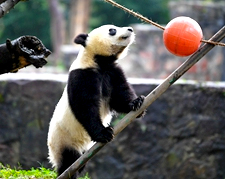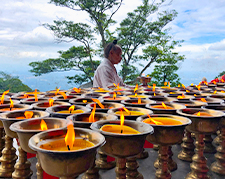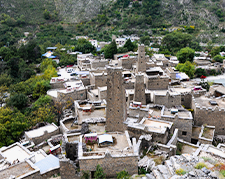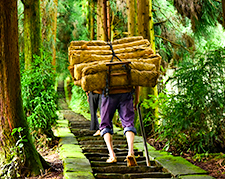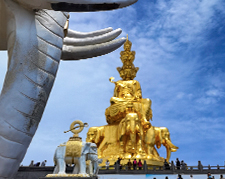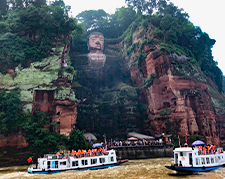Trip Details
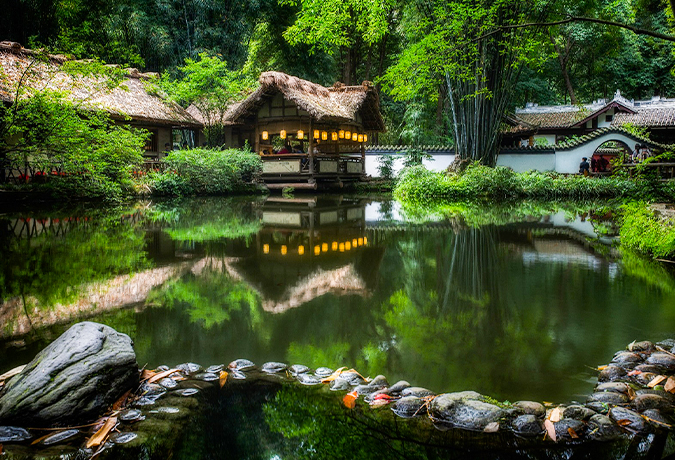
8 Days Photography Journey around Chengdu
Date: May.21 to May.28, 2026
Price: From 1950USD/PAX
Trip Focus: Photo + Heritage
Status: Open to Booking
Route: Chengdu-Dujiangyan Panda Base-Mount Qingcheng-Taoping Qiang Village-Mount Mengding-Mount Emei-Leshan-Chengdu
Trip Code: PH007
Overview
Embark on this photography journey around Chengdu to encounter diverse charms. Step into the Dujiangyan Panda Base, where you can capture with your lens the moments of adorable giant pandas frolicking and lazily feeding, their fluffy cuteness melting everyone's heart. Wander through Qingcheng Mountain, a holy land of Taoism, where ancient trees tower into the sky and palaces and temples are hidden among them. The morning and evening light casts on the upturned eaves and winding stone steps, fully showcasing the profoundness of Taoist culture. Head to Taoping Qiang Village, where the ancient watchtower clusters, intricate alleys, and distinctive Qiang-style dwellings tell the long history of the Qiang people. The Qiang people dressed in ethnic costumes add a rich humanistic atmosphere to the pictures. Climb Mount Mengding, where in the mist-shrouded tea gardens, the tender green tea trees are layered like green waves. The elegant tea-making and tea-brewing actions of tea artists demonstrate the unique charm of tea culture. Rush to Mount Emei, where the Shifang Puxian Statue on the Golden Summit is solemn against the backdrop of sea of clouds and sunlight. The agile monkeys, strange pines, and grotesque rocks along the way are all rare shooting subjects. Finally, arrive in Leshan, where the grand Leshan Giant Buddha stands by the river, complementing the magnificent scenery of the confluence of three rivers. The streets and alleys filled with the fragrance of delicious food and the lively life scenes are also worth recording. This photography journey integrates natural beauty, humanistic customs, and historical heritage, bringing a wonderful visual and spiritual journey.
Highlights:
• Become a Panda Volunteer and Experience a Day as a Panda Keeper.
• Exploring World Natural and Cultural Heritage Sites.
• Experience the Joy of Tea Picking at Mengding Mountain with Your Own Hands.
• Admire Sunrise and Sea of Clouds on Buddhist Sacred Mountain.
• Savor Local Specialty Delicacies to Satisfy Your Taste Buds.
• Guided by dedicated and experienced, local nature guide from AbsolutePanda team.
Introduction to Trip Destinations and Activities:
Dujiangyan Panda Base
Dujiangyan Panda Base, also called Dujiangyan Panda Ark, is located at the foot of Mt. Qingcheng. Mainly focusing on panda rescue, husbandry, and disease control, its facilities have a critical impact on the continued survival of the Giant Panda. It takes about a 1.5-2 hours drive from downtown Chengdu to arrive at the base.Our visit to the panda base here will feature the exciting hands-on opportunity to assist the panda caretakers in their daily routine.Here, you can take photos of the lovely pandas and the daily work of the volunteers.
Mount Qingcheng
Located near the scenic city of Dujiangyan, Mount Qingcheng is one of the best places to visit to gain a deeper perspective on China’s indigenous religion of Taoism. With a history spanning hundreds of years, Qingcheng is a host to a variety of temples showcasing the elegant architectures of Taoist traditions. Visitors can navigate a series of staircases winding up through peaceful forests in search of practitioners and temples dedicated to notable Taoist deities and figures. Here, you can take photos of pavilions, terraces, towers, and Taoist temples.
Taoping Qiang Village
Taoping Qiang Village is known as the "Mysterious Oriental Castle". Founded in 111 BC, it has a history of over 2,000 years, serving as a typical representation of Qiang architectural complexes and completely preserving the ancient ethnic characteristics of the Qiang people.Its unique charm lies in watchtower-style castles with underground water networks, extended passageways, and labyrinthine patterns integrating watchtowers, forming a 3D road and defense system covering ground, underground and air.Here,you can take photos of Qiang ethnic architecture and local cultural customs.
Mount Mengding
Mount Mengding gets its name from the "mist and rain that shroud it". As the birthplace of world tea culture, it was here that Wu Lizhen domesticated and planted wild tea trees during the Western Han Dynasty, pioneering the history of artificial tea cultivation. The Mengding mountain tea produced here was listed as a tribute from the early Tang Dynasty to the late Qing Dynasty, earning Mount Mengding the reputation of the "Hometown of Immortal Tea".Here, you can take photos of tea mountains and tea pickers.
Mount Emei
Mount Emei is one of the four great Buddhist mountains in China. Many temples such as Baoguo Temple and Wannian Temple carry profound Buddhist cultural heritage, serving as the Bodhimanda of Samantabhadra Bodhisattva. The Buddhist culture here has a long history, with each dynasty since the Eastern Han Dynasty regarding it as an important place for Buddhist development, preserving a large number of Buddhist relics and historical sites.Here, you can take photos of the sea of clouds and the Golden Summit of Mount Emei.
Leshan Giant Buddha
Holding the distinction as one of the world’s largest sitting Buddhas and oldest pre-modern structures, the Leshan Buddha has become one of China’s most iconic world heritage sites. Leshan Giant Buddha is the world-largest stone Buddha, a World Cultural and Natural Heritage site since 1996 by UNESCO.The 70-meter high Giant Buddha was carved out of rock from a hill called Linyun Mountain located at the junction of the Minjiang River, Dadu, and Qingyi Rivers.Here, you can take photos of the entire view of the Leshan Giant Buddha.
How Can We Make This Trip Special?
• Many times of running this itinerary for western nature and culture lovers enables us to ensure your photography trip is enjoyable and comfortable in the hidden area.
• A team of passionate guides specializing in photography and wildlife with rich experiences of guiding and solid knowledge about local cultures and places.
• This trip can be customized to better meet your travel style by centering on a different focus.
• 20-plus years of working in the travel industry and serving travelers from all over the world enable us to know how to make great trips for travelers of different travel styles.
What makes AbsolutePanda excellent?
• We are one of the premier travel companies focusing on panda and other wildlife in China.
We use AbsolutePanda as company brand because of our deep love toward panda and our determination to create your absolutely enjoyable panda trips.
Since 2003, our professional tour leaders and wildlife experts have helped thousands of travelers gain an in-depth understanding of Giant Panda and their companion animals, enjoy stunning scenery all over China and explore the authentic local culture.
• Exclusive Quality & Value Guarantee.
We define our quality by well-designed itineraries, stunning destinations, creative interactions, small groups, professional guides, and reasonable prices.
• Explore China in comfort and your style.
We understand each traveler is different. In addition to selected accommodations, meals and vehicles, we would like to show you the real China by an authentic experience with incredible wildlife and lovely locals.
• We care and share.
We believe the best way to help wildlife is through love and appreciation. By bringing nature lovers to enjoy the beauty of nature in China, we hope that local people can know the value of wildlife and learn how to love and appreciate those beautiful creatures living near their villages.
Map
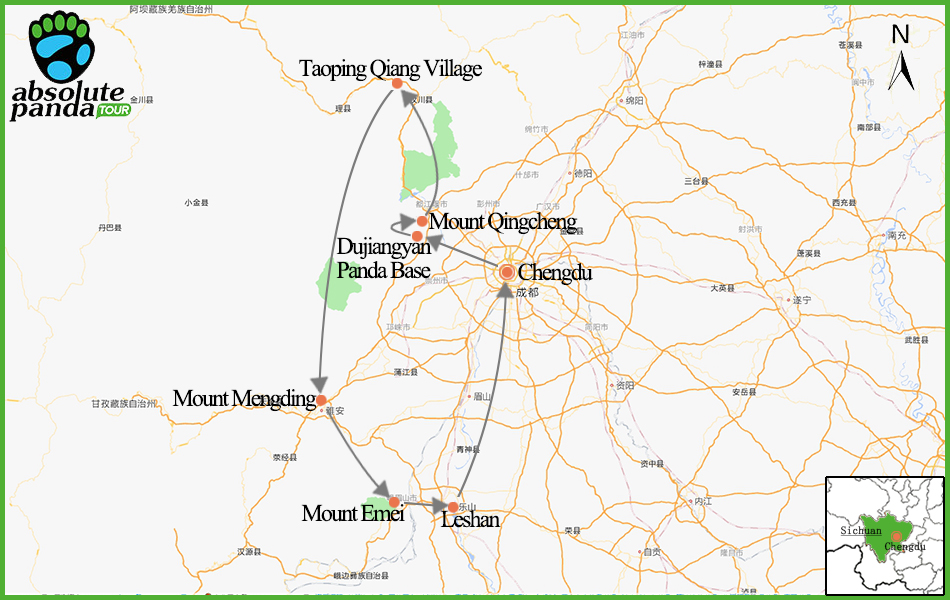
Photography Journey around Chengdu Map
Itinerary
Outline:
Day 1. Arrive in Chengdu. (D)
Airport pick-up. Welcome dinner and introduction to the team and itinerary.
Overnight: Chengdu
Day 2. Chengdu-Dujiangyan Panda Base-Mount Qingcheng (64km 2h) (BLD)
Volunteer work at the Dujiangyan Panda Base in the morning. Travel to Mount Qingcheng for a visit in the afternoon.
Overnight: Dujiangyan
Day 3. Dujiangyan-Taoping Qiang Village(148km 2.5h)-Mount Mengding(244km 3h) (BLD)
In Taoping Qiang Village, learn about its history and enjoy the scenery. In the afternoon, head to Mount Mengding to experience life in the tea mountains.
Overnight: Mount Mengding
Day 4. Mount Mengding-Mount Emei. (92km 1.5h) (BLD)
In the morning, we will head to Mount Mengding for a hike. After that, proceed to the Mount Mengding tea gardens, change into appropriate attire to pick tea leaves, and take away the freshly processed tea after on-site production.
Overnight: Mount Emei
Day 5. Explore in Mount Emei. (BLD)
Spend the whole day exploring in Mount Emei.
Overnight: Mount Emei
Day 6. Mount Emei-Leshan(93km 2h). (BLD)
Set off for the Leshan Giant Buddha Scenic Area in the morning. And head to the Oriental Buddha Park for a visit. At noght, we will go to Jiaxing Road Food Street to taste Leshan's local cuisine.
Overnight: Leshan
Day 7. Leshan-Chengdu.(149km 2.5h) (BLD)
Return to Chengdu and proceed to visit Du Fu Thatched Cottage and Jinli.
Overnight: Chengdu
Day 8. Chengdu departure. (B)
Airport drop-off.
Details:
Day 1. Arrive in Chengdu. Meals: D
Airport pick-up. Based on the time your time of arrival, we can plan some city tour programs for you such as visiting People’s Park to experience the typical laid-back lifestyles of Chengdu or visiting Jinli Street to feel the bustling shopping street with all types of shops selling unique local souvenirs or sample an array of delicious food from stands of the food street.
In the evening, you will enjoy a sumptuous welcome dinner at local popular restaurant and itinerary-briefing by your guide. At the dinner, trip participants will get to know each other and sample a great variety of local dishes.
Overnight: Chengdu
Day 2. Chengdu-Dujiangyan Panda Base-Mount Qingcheng (64km 2h) Meals: BLD
In the morning, spend half a day as a volunteer at the Dujiangyan Panda Base, getting up close to the lovely giant pandas—helping with their care, preparing their food, and learning more about these national treasures from the keepers. In the afternoon, head to Mount Qingcheng, where you can wander along its winding paths, breathe in the fresh air filled with the scent of greenery, and admire the serene temples nestled among the lush mountains, letting the tranquil beauty of nature wash over you.
Shooting focus:
Dujiangyan Panda Base. Use a wide-angle lens to record the log perches, climbing vines and simulated caves in the panda villas. Compose the shot through the semi-open activity grounds shaded by green bamboos to showcase the base's design concept of "simulating wild habitats"; focus on the constant temperature system and enrichment facilities (such as ice cubes and bamboo tube toys) in the enclosures, take close-up shots of pandas rolling on the mossy stone beaches to reflect the professionalism of animal welfare and ecological conservation. Capture the "thumb" grip when giant pandas eat bamboo shoots and the clumsy movements of cubs climbing among tree branches, record the streamlined posture of pandas swimming with a slow shutter to reveal their semi-aquatic habits; wait to shoot the cute look of pandas napping in the afternoon, capture the interesting moments when bamboo leaves cover their faces, and convey the species' characteristics and the value of biodiversity through these adorable images.
Mount Qingcheng. Use a wide-angle lens to capture the silhouettes of bamboo rafts gliding through the mist on Yuecheng Lake, show the ferns hanging from the cliffs behind Tianshi Cave and the mossy stone paths from an upward angle, and display the layered vegetation of Mount Qingcheng, which is known as "the most secluded mountain under heaven", with the seasonal colors of golden ginkgo leaves in autumn; take close-up shots of the spruce crowns reflected in the streams and the swimming rock carp, connecting the vitality of the mountain forest ecosystem through the element of water. Focus on the lines of the upturned eaves of Shangqing Palace cutting through the mountain fog, exaggerate the mechanical beauty of the brackets in Zushi Hall with a fisheye lens, record the mottled texture of the "Tai Chi Bagua" reliefs on the stone railings of Sanqing Palace coexisting with moss to demonstrate the Taoist architectural concept of "following the laws of heaven and earth"; capture the dynamic echo between the arc of the broom and the outline of the ancient buildings when a Taoist priest sweeps the fallen leaves in front of the temple, strengthening the living inheritance of the buildings through humanistic scenes. Take close-up shots of the weathered traces of the "Subduing Demons" cliff carvings on the Zhibi Trough, shoot against the light to capture the light penetration of the "Tao begets one" plaque at the mountain gate of Yuanming Palace to interpret the material carrier of Taoist cosmology; record the overlapping composition of the eight-trigram floor tiles in the bronze hall of Laojun Pavilion and the red strings for tourists' prayers, connecting the thousand-year-old religious tradition with modern belief symbols; follow and shoot the interweaving of virtual and real between the sleeves and the reflection of ancient cypresses when morning exercisers practice Tai Chi in front of Zushi Hall. Take advantage of the blue hour before dawn to shoot the Tyndall effect of the morning sun penetrating the window lattice of Shangqing Palace, outlining the contours of the futons in the hall with light beams; take a view at Ciyun Pavilion in the evening, use a slow shutter to record the color trails of the prayer flags fluttering in the mountain wind, creating a cold-warm contrast between the orange-red sunset and the green tiles of the Taoist temple; wait at the corridor bridge of Yuecheng Lake on a rainy night, capture the star trails formed by raindrops in the light of lanterns to create the Oriental artistic conception of "in the night rain of Qingcheng".
Overnight: Dujiangyan
Day 3. Dujiangyan-Taoping Qiang Village(148km 2.5h)-Mount Mengding(244km 3h) Meals: BLD
In Taoping Qiang Village, you can immerse yourself in its profound historical tapestry—wandering through the labyrinthine alleys of this ancient stone fortress, listening to the elders tell the traditional stories of the Qiang people, and marveling at those well-preserved watchtowers, which, like silent witnesses, speak of centuries of tenacity and inheritance. As you stroll around, your eyes will be met with unique architectural features everywhere. The gray stone walls blend harmoniously with the surrounding mountains, and a strong local flavor permeates the air, making every corner a delight to the senses.
In the afternoon, head to Mount Mengding, where the rolling tea gardens spread like a green blanket over the slopes. Step into the world of tea cultivation: pick fresh tea leaves with your own hands under the guidance of local tea farmers, learn the delicate techniques of sorting and withering, and breathe in the earthy fragrance filling the air. When you engage in these age-old tasks, you will not only get to taste the essence of the famous tea produced here but also deeply feel the close connection with this land and the generations of people who have nurtured this timeless craft.
Shooting focus:
Film the dynamic moments of elderly people weaving Qiang embroidery with silver threads shuttling, women making buckwheat cakes with smoke rising from the stove, and children running in the alleys to showcase the contemporary inheritance of Qiang intangible cultural heritage; use a wide-angle lens to capture the rough textures and geometric contours of the stacked stones of the watchtowers, and through the defensive structure of the observation holes and the interlacing light and shadow in the labyrinthine bluestone alleyways, display the Qiang people's defensive architectural concept of "building a city against the mountain" and the vicissitudes of the thousand-year-old village; compose a picture from the high point of the hillside, incorporating the watchtowers of the Qiang village, surrounding terraced fields and tributaries of the Minjiang River into the panorama, and highlighting the Qiang people's living philosophy of "harmony between man and nature" with the seasonal colors of pear blossoms in spring and corn in autumn; capture the silhouettes of the watchtowers in the mist at dawn and dusk, and the warm light and shadow of the alleyways under the slanting sunset, using natural light to strengthen the aesthetic echo between the buildings and the environment.
Overnight: Mount Mengding
Day 4. Mount Mengding-Mount Emei(92km 1.5h) Meals: BLD
At dawn, when the sky is just starting to lighten, set off on a hiking trip to Mount Mengding. The thin mist in the mountains has not yet dispersed; as you step on the winding stone steps, you can hear the crisp birdsong mingling with the sound of your own footsteps. Breathing in the air filled with the fresh fragrance of plants and trees, every step feels like a conversation with nature. When you reach the top of the mountain, you happen to see the morning sun breaking through the clouds, gilding the rolling mountains with a layer of golden light. The scenery in the mountains gradually becomes clear in the morning light, making people feel relaxed and happy.
After a short rest, head to the tea gardens of Mount Mengding. Change into light tea-picking clothes, and follow the tea farmers to learn to identify the freshest tea buds. Pinch the tips of the tea leaves gently with your fingertips and pluck them, then put them into the bamboo basket around your waist. Before long, you will have harvested half a basket. Then participate in on-site processing and production. Watch as the fresh tea leaves go through processes such as fixation, rolling, and drying in the hands of the tea-frying masters, gradually emitting a mellow tea fragrance. Finally, carefully pack away your own portion of tea leaves, filled with a sense of accomplishment.
In the afternoon, set off for Mount Emei. After arriving, take a short rest at your accommodation first to wash away the fatigue of the journey and recharge your energy. As night falls, come to the performance venue of Only Mount Emei. As the lights come on, the real scenery and the actors' performances blend together, as if traveling through time and space. You can feel the thousand-year-old culture and legends of Mount Emei in the changing light and shadow. Every scene is immersive and memorable.
Shooting focus:
At the ancient tea workshop of Tiangai Temple, follow and shoot the gesture trajectory of the tea-frying master's, with the temperature of the iron pot and the green smoke from the rolling tea leaves forming a dynamic montage; use a slow shutter to shoot the silky texture of the tea juice oozing during the rolling process, contrasting the texture of the tips of new tea buds with the rough palms of old tea farmers; take a close-up of the fresh leaves spread out to dry in the bamboo plaque, use the light beam coming through the window to illuminate the veins of the leaves, and match it with the mottled copper rust of the Ming Dynasty "The First Pot Under Heaven" sculpture in the background to interpret the inheritance narrative of "a thousand-year tea vein".
In the tea fields surrounded by the five peaks of Mengding Mountain (Shangqing, Lingjiao, Jingquan, Ganlu, Yunv), capture the fluffy texture of the new shoots of tea trees in the morning mist in May, and outline the "S"-shaped curve of the tea ridges with side light; use a drone to take an aerial shot of the interweaving of light and shadow between the ten-thousand-mu tea garden and the tributaries of the Qingyi River, allowing the thin mist to flow between the tea bushes to form a "sea of clouds and tea waves"; use a macro lens to get close to the buds of "Mengding Yellow Buds", record the refracted light spots of morning dew on the fluff, and match the blurred old tea tree trunks in the background to show the generational replacement of tea trees.
At the site of Zhiju Temple, use a medium-focus lens to frame the diagonal composition of the Tang Dynasty stone pillars and tea ridges, allowing the moss on the broken steles and the new shoots of tea trees to form a dialogue across time; use a slow shutter to shoot the interweaving trajectory of the steam from the tea cup and the candle smoke in the hall when the monk offers tea to the ancient Buddha; take a macro shot of the tea stains on the well rail of "Mengquan" in Tiangai Temple, and match the tea flowers falling into the well to show the materialized symbol of "Zen and tea in one taste".
Shoot the "Tyndall light pillars" in the gaps between the clouds on Ganlu Peak, the matrix of light spots formed on the ground when they penetrate the tea bushes; use a long exposure to record the flowing texture of the tea-colored sea of clouds at dusk, allowing the warm light of the ancient temple lanterns to form a cold-warm balance with the deep blue of the clouds and mist, echoing the mythical mood of "Mengding fairy tea".
Overnight: Mount Emei
Day 5. Explore in Mount Emei. Meals: BLD
In the early morning, Mount Emei is still immersed in thin mist. Along the winding mountain path upwards, the morning light filters through the branches and leaves of ancient cypresses, casting dappled shadows. Occasionally, one can catch a glimpse of monkey groups leaping nimbly between tree trunks, drawing soft exclamations from tourists. When arriving at Qingyin Pavilion, listen to the clear roar of the Black and White Waters crashing in front of the Ox-Heart Stone. The pool water reflects the surrounding pavilions and towers, like a flowing ink painting.
In the afternoon, take the cable car to the Golden Summit. The sea of clouds surges beneath your feet. When the sun penetrates the clouds, the sea of clouds and Buddha's light near the Shendao Cliff flicker faintly. The Golden Hall and Copper Hall shine brilliantly in the sunlight, with the distant Gongga Snow Mountain standing majestically, forming a magnificent picture. In the ancient temples along the way, such as Jieting Temple and Taizi Ping, incense curls, and the sound of chanting mingles with the mountain wind, exuding a serene and distant atmosphere.
In the evening, walk slowly down the mountain. The setting sun gilds the mountains and forests with a warm golden hue. The yellow tiles of Wannian Temple are particularly eye-catching in the twilight. The bronze statue of Samantabhadra inside the temple stands quietly, as if witnessing the rising and setting of the sun and moon in the mountains. The dove trees on the mountain road spread their white bracts, like a group of white doves about to take flight, adding a touch of agility to the day's journey. One can deeply indulge in the fairy mountain charm of Mount Emei in the integration of nature and humanity.
Shooting focus:
At Wannian Temple, frame the arch structure of the beamless hall from the Ming Dynasty, creating a geometric contrast between the bronze bells on the eaves and the colorful azaleas blooming under the eaves; use a slow shutter to shoot the interweaving of virtual and real between the trajectory of the broom and the moss on the stone steps when monks sweep the fallen leaves; take a macro shot of the tea stains on the "Shengji Evening Bell" at Baoguo Temple, paired with the dove tree bracts falling on the bell surface, to show the materialized symbol of "the unity of Zen and tea".
On the section from Leidongping to Jieting Temple, capture the double-petaled folds of Rhododendron fortunei (at an altitude of 2200 meters), using side light to highlight the translucent texture of the petals; use a drone to take an aerial shot of the color block of Rhododendron lacteum and fir forests in the Wanfo Summit area, allowing the flower clusters to form "colorful contour lines" along the mountain ridge; bring a macro lens close to the endemic species of Mount Emei, "Rhododendron calophytum", to record the moment when insects crawl on the stamens and pollen splatters, with the background blurred to handle the mottled rock texture.
Shoot the "flowing cloud waterfall" where the sea of clouds overflows Shendao Cliff with a wide-angle low-angle shot, creating a color contrast between the cool-toned blue mist and the warm light of the Golden Summit Copper Hall; when the Buddha's light appears, use a medium-focus lens to capture the dynamic overlap between the tourists' figures and the halo, and use a polarizer to eliminate the fog reflection to highlight the rainbow-colored halo; in the twilight, use a long exposure to record the flowing trajectory of the tea-colored sea of clouds, allowing the gilded luster of the Golden Statue of Samantabhadra and the deep blue of the clouds and mist to form a cold-warm balance.
Overnight: Mount Emei
Day 6. Mount Emei-Leshan(93km 2h) Meals: BLD
In the early morning, set off for the Leshan Giant Buddha Scenic Area. From a distance, you can see the huge Buddha statue sitting by the river. Though it's just a quick preview, you can already feel its solemnity. The river flows slowly beneath your feet, as if telling stories of a thousand years.
In the afternoon, head to the Oriental Buddha Park. The Buddha statues here are in various forms, some sitting, some standing, with vivid expressions. Wandering among them, it's like being in a Buddhist world. Looking closely at those exquisitely carved Buddha statues, you can see the delicate lines left by the craftsmen, each part revealing a devout interpretation of Buddhist culture.
As night falls, Jiaxing Road Food Street gradually becomes lively. The shops along the street light up with warm yellow lights, and the air is filled with the aroma of various delicacies. Whether it's the crispy-skinned sweet duck with a tender interior, the spicy and flavorful boboji (skewered snacks), or the smooth and refreshing tofu pudding, they all make your mouth water. Find a small shop to sit down and savor these authentic Leshan delicacies, and all the fatigue of the day fades away in this atmosphere of daily life.
Shooting focus:
Shoot at the Giant Buddha Platform, which is an excellent location to capture the panoramic view of the Giant Buddha. It can include the entire 71-meter-high Buddha and the magnificent scenery of the confluence of the three rivers in the shot. In May, the river water is emerald green, forming a sharp contrast with the Giant Buddha. You can also choose to take a cruise ship and shoot the Giant Buddha from the river upwards, with the blue sky as the background to highlight its grandeur, while recording the landscape painting of the Giant Buddha with the Minjiang River, Qingyi River and Dadu River.
Walking down the Nine-Bend Plank Road, you can shoot the Giant Buddha from different angles and details, such as its facial expression, hands and feet, to show the exquisite craftsmanship of ancient artisans. Use a telephoto lens to capture the figures of tourists on the plank road, contrasting with the Giant Buddha to reflect its magnificence. In the middle section of the plank road, shoot the Giant Buddha and the sky in the same frame from a low angle to enhance the momentum of the picture with a wide-angle lens.
Wuyou Temple is located in the scenic area. The ancient buildings and gardens in the temple are good backgrounds for taking photos. You can shoot the beautiful scenery where Wuyou Temple and the Giant Buddha set off each other. You can also focus on the overhanging eaves, brackets, release pool, etc. in the temple, and use the telephoto compression effect to shoot the reflection of ancient buildings, which is suitable for taking ancient-style photos.
The entrance of Mahao Cliff Tombs is also a good shooting spot. Using the door frame for composition, combined with the mottled light and shadow of the red wall, you can take pictures with a strong sense of history.
Leshan has a variety of delicious foods, and you can focus on shooting footbath beef, boboji (skewered snacks), crispy-skinned sweet duck, etc. For footbath beef, you can shoot the steaming soup pot, the fresh and tender color of the beef, with green coriander and chopped green onions to show its tempting appetite. For boboji, focus on the picture of the skewers soaked in the red oil soup. The bright red of the red oil and the rich colors of the ingredients make people salivate. For crispy-skinned sweet duck, you can shoot the shiny luster of its skin and the tenderness and juiciness of the duck meat after being cut open.
Overnight: Leshan
Day 7. Leshan-Chengdu (149km 2.5h) Meals: BLD
After breakfast, we will take a bus back to Chengdu and visit Du Fu Thatched Cottage. The bluestone paths wind through the lush bamboo forests, with thatched cottages, flower-lined paths, and the Hall of Poetic History standing quietly. The air is filled with a faint fragrance of ink and the freshness of plants. Standing in front of the statue of Du Fu, it feels as if we can hear the poet chanting a thousand years ago. Through those weathered stone steles and displayed ancient books, we can touch the pulse of poetry from the prosperous Tang Dynasty.
In the late afternoon, we will head to Jinli for a visit. Red lanterns hang high along the alley corridors. Various shops selling Shu embroidery, bamboo weaving, and sugar paintings attract people to stop frequently. The sounds of shouting, laughter, and the gongs and drums from Sichuan opera face-changing performances interweave into a lively marketplace symphony. Find a tea stall to sit down, watch the steam from the covered-bowl tea curl up, and gaze at the flickering shadows of shadow plays at the end of the alley. In this ancient-style street, feel the slow-paced hustle and bustle of Chengdu.
Shooting focus:
The red walls of Du Fu Thatched Cottage are a iconicnd green bamboos set off each other, forming a striking color contrast. Near the flower-lined path, a telephoto lens can be used to compress the space and take close-up shots of the red walls and bamboos, showcasing the beauty of their lines and colors.
The thatched cottage is where Du Fu lived in his time. Surrounded by lush vegetation, it is full of pastoral charm. You can take a panoramic shot of the thatched cottage to display its simple and unsophisticated appearance and the surrounding natural environment, embodying the artistic conception of "a bamboo gate hiding green bamboos". You can also walk into the cottage and shoot the restored indoor living scenes, such as the desk and bed. Through close-up shots to show the details, you can feel the living atmosphere of Du Fu in those years.
The garden in the cottage is pleasant. In the pond, lotus leaves are just unfolding, jade lotuses are in full bloom with a delicate fragrance, and white gardenias and roses are lingering with a intoxicating residual fragrance. You can take pictures of aquatic plants such as lotus and water lily in the pond, and use a macro lens to capture the details of the flowers and the crystal clarity of water droplets on the petals. You can also shoot the paths, rockeries, pavilions and other structures in the garden, paired with the surrounding green plants to show the tranquility and elegance of the garden. Different composition methods, such as frame composition and symmetrical composition, can be used to enhance the beauty of the pictures.
Du Fu's Thousand Poetry Steles are a cultural highlight in the cottage. You can take pictures of the poetry calligraphy on the steles, and use close-up shots to show the charm of the fonts and the texture of the steles.
Overnight: Chengdu
Day 8. Chengdu departure. Meals: B
On the final day of the itinerary, our team will escort you to the airport or train station to depart from Chengdu on time.
Notes:
1. If you need help in arranging a flight to Chengdu from other major cities of China such as Beijing, Shanghai, Xian, or a departure flight from Chengdu, please feel free to contact us, we are more than happy to provide any support we can to facilitate your trip planning.
2. The overnight altitudes and driving hours listed in the itinerary are just for your rough reference.
Dates & Prices
1. Dates
21th May to 28th May, 2026
AbsolutePanda can tailor-make this trip according to your time and interest.
2. Prices
The AbsolutePanda team works hard to provide the highest quality tour experiences at a fair price. However, after working in the travel industry for more than 20 years, our team knows that no two travelers are alike in terms of their travel style, personal interest, choice of guides and preferences in restaurants and hotels. For AbsolutePanda, our client’s satisfaction is a top priority. To meet the needs of different clients and ensure they enjoy a trip suited to their preferences, you are welcome to email with specific requests ranging from trip themes, guides, the quality of vehicles, accommodations, and restaurants. Our group trip price has the following includes and excludes below.
To ensure our guest the best trip, we set our minimum departure number at four and the maximum departure number at twelve. That means the group size is 6 to 12 participants.
The cost for a group of 6 to 12 people:
1950 USD/PAX
Single supplement:
286 USD/PAX
The cost includes:
1. Well-chosen vehicles based on the size of the group for the trip with fuel, tolls, airport pick-up and drop-off included in the price;
2. An English-speaking guide for the whole trip;
3. Meals as indicated by BLD (B for breakfast, L for Lunch and D for dinner)in the itinerary. Picnic lunch when photograph in the field.
4. Complimentary water and snacks during the trip.
5. Entrance fee for the scheduled spots visited with guide in the itinerary .
6. China Domestic Travel Insurance;
7. Hotels arranged during this trip.
The cost excludes:
1. Alcoholic drinks during the meal;
2. Extra charges due to change of itinerary from client-side or factors beyond the control of AbsolutePanda such as natural disaster and governmental policy change;
3. Discretionary tips to the guide and driver;
4. All personal expenses, such as laundry service or for personal shopping;
5. Train ticket or airfare to or out of Chengdu;
6. Any items not listed in the itinerary as included;
7. Entrance fee, car rental, or meals during your free time trip;
8. Extra nights in Chengdu.
Notes:
1. The prices above are not applicable during any Chinese festivals and holidays. We recommend you to avoid travelling during Chinese festivals and holidays for a better experience.
2. For travelers who hope to tailor-make the day programs with their specific travel preferences in mind (transportation, hotels, special privileges, and famous local experts), tailor-making a tour is the best way to ensure your desires are met. Please contact us with your specific needs and we will make an itinerary based on your expectations. Once you confirm, we work out the cost and send it to you. Please feel free to ask any questions to learn more.
3. Please note that guides with specialized knowledge are not always available, especially during our peak tour season (April to October). If you are in the process of planning a trip, please contact us as early as possible so that we will block the date of our expert guide for you.
With your precious trust on us, we will definitely do our utmost to make your trip most enjoyable!
Accommodations
AbsolutePanda firmly believes travel is an art. To ensure every trip with us is a great travel art for our clients, the AbsolutePanda team does all we can to consider every possible detail. The choice of hotels is an essential part of making a great trip. After many years of running a travel business, we have built up our network of cooperative hotels at different levels. We understand people are different in the choice of hotels when they travel. If you want to use some specific hotels, please feel free to let us know, we are delighted to book it for you at a competitive price to make the hotel choice better meet your taste, budget and travel style. We can either reserve a hotel with competitive price for you or simply include the hotel into your trip cost if possible. You are welcome to contact us and tell us your requests, we will do our best to create the best travel itinerary for your private use.
If you need help with hotel booking in other big cities of China at different styles and luxury levels (International-brand Hotels, Local Brand Hotels, Economical Hotels), please feel free to email our team at info@absolutepanda.com.
FAQs
1. What exactly do volunteers do in the volunteering program?
After check-in, document-reviewing, staff briefing and changing clothes, the volunteers for the day will be divided into several groups and each group will be led by a CCRCGP staff to the designated work site. There, volunteers will work under the guidance of a panda keeper to do the daily routine works for a panda including making the panda’s food, preparing bamboos and so on. After the volunteering program, you will get a volunteer certificate.
2. Are the pandas at the base wild?
The pandas at this facility are all living in specialty enclosures specifically designed to provide them with a natural environment in a captive setting.
3. If we want to arrive Chengdu in advance or spend more days here after the tour, can AbsolutePanda arrange that for us?
Yes, absolutely. We are more than happy to help our guest to book services and arrange day tours of Chengdu. Please check our website for more day tour options and send us your requirements. We can tailor-make a suitable tour plan for you.
Email us if you have any questions. Read our FAQ
Testimonials
What an amazing experience!
We just returned from a trip to China. Our time with Absolute Panda was the highlight of our trip! We were nervous about finding a company online, and paying for services out of the country. AbsolutePanda was completely honest with us. They were affordable.We had pretty specific interests. The staff at AbsolutePanda helped us through the planning process. They created something perfect for our family! They spent months offering free advice, suggestions, and help. They were flexible with the itinerary. Once in the country, we were treated well. They asked for and supported dietary requests. We got to try a great variety of healthy and delicious food. We had as much bottled water and snacks as we liked. All meals were included in the price. We received small gifts. The company owner checked in, to make sure we were doing ok. We felt like royalty! We stayed at beautiful, and clean accommodations, “off the beaten path.” We went to small mountain towns. They were gorgeous.Our guide, Bella, was exceptional! She was kind, friendly, interesting, reliable, and lots of fun. She spoke very good English. She had an extensive knowledge of local wildlife, as well as history, culture, and everything else we asked. Bella was able to identify any bird or creature she saw, by Chinese and English name. She has great eyes. She could spot wildlife in the distance, that were hard to see even with binoculars. She took us on hikes that matched our skill levels. We saw wild monkeys, gorals, muntjacs, and tons of beautiful birds. We were in highly competent hands. While we were in China, Sichuan had (unprecedented) heavy rains. Some roads were closed, due to mudslides and flooding. Despite this, we were able to travel the areas we wished. AbsolutePanda kept a close eye on conditions. They changed the travel plan/method multiple times, so we could be safe. They got us there still. The drivers were amazing, and I felt comfortable. We changed our own plans in China. This was due to unexpected medical issues we had there. AbsolutePanda worked with us, even with last minute adjustments. They were supportive, helpful, and flexible. They made sure each member of our family was well cared for. Our safety and well-being mattered to them. I can’t recommend AbsolutePanda highly enough! They gave us the trip of a lifetime!
--Suzucchini
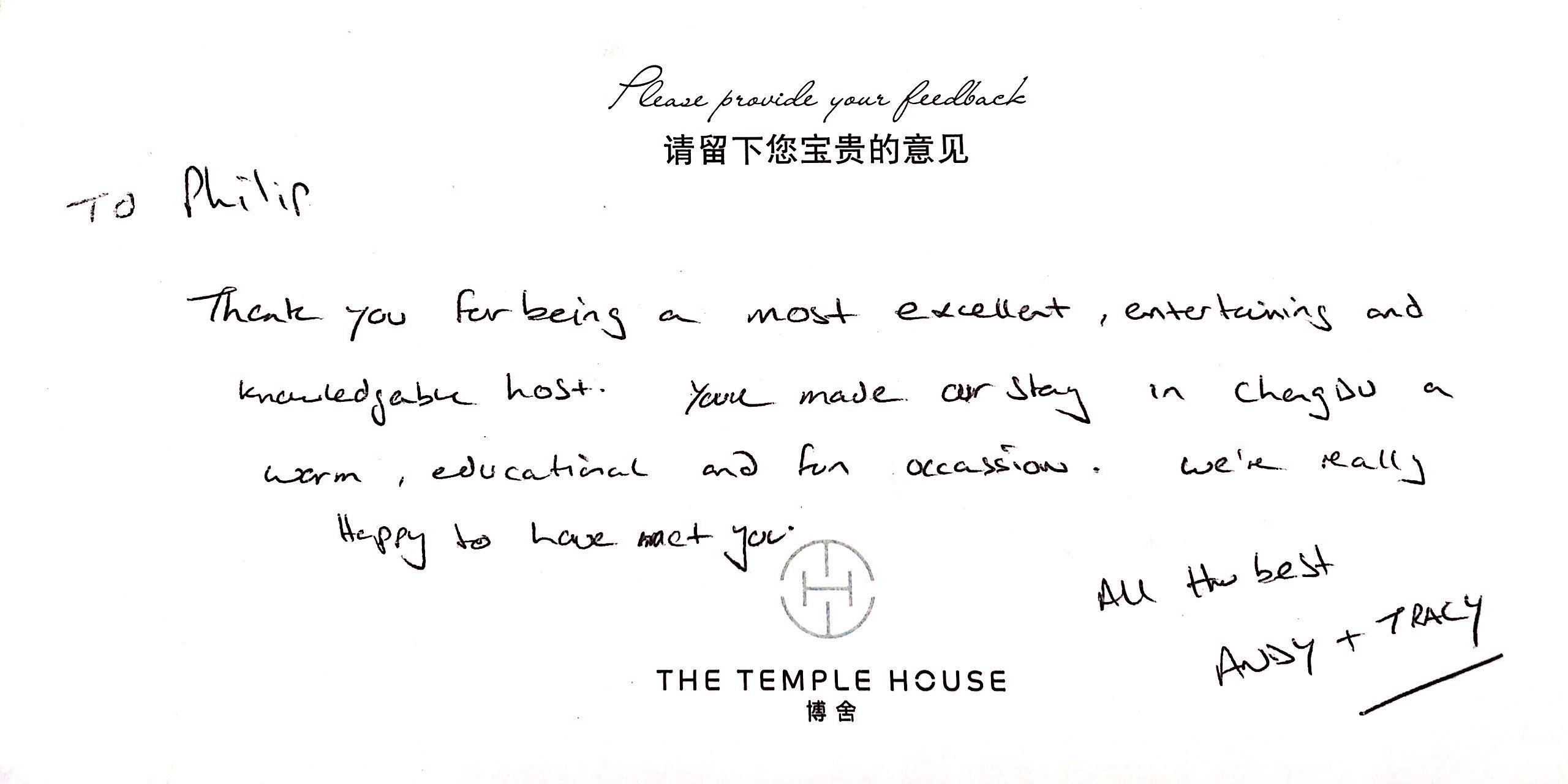
Videos & Photos
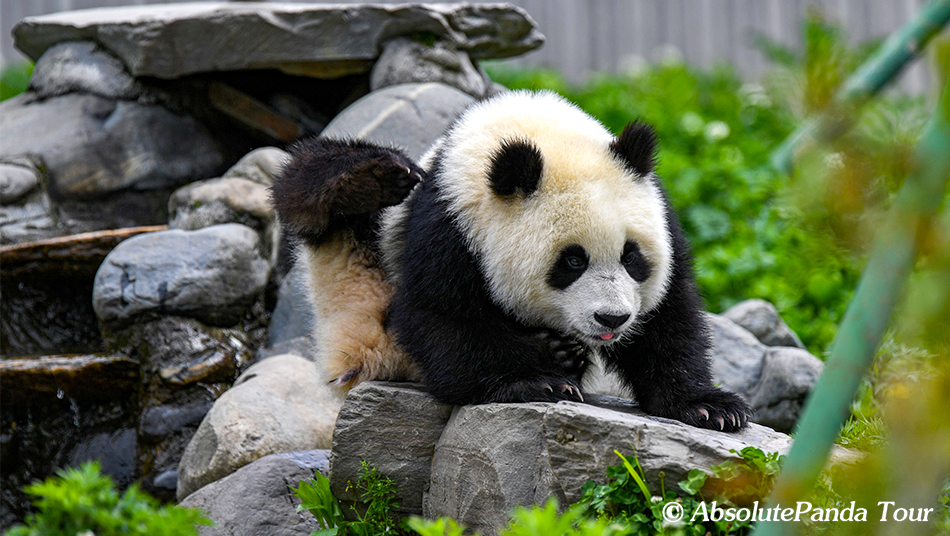
The giant panda in Chengdu.
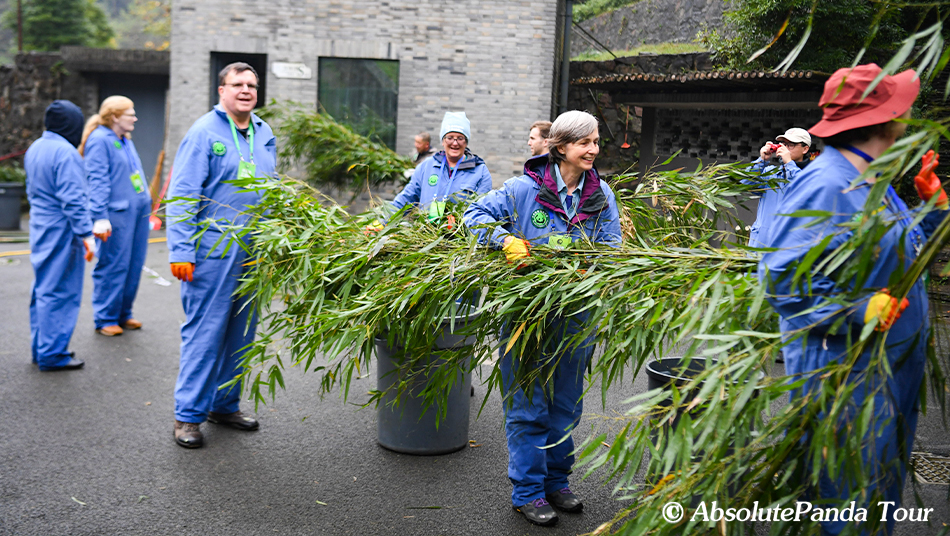
Dujiangyan Panda Volunteer
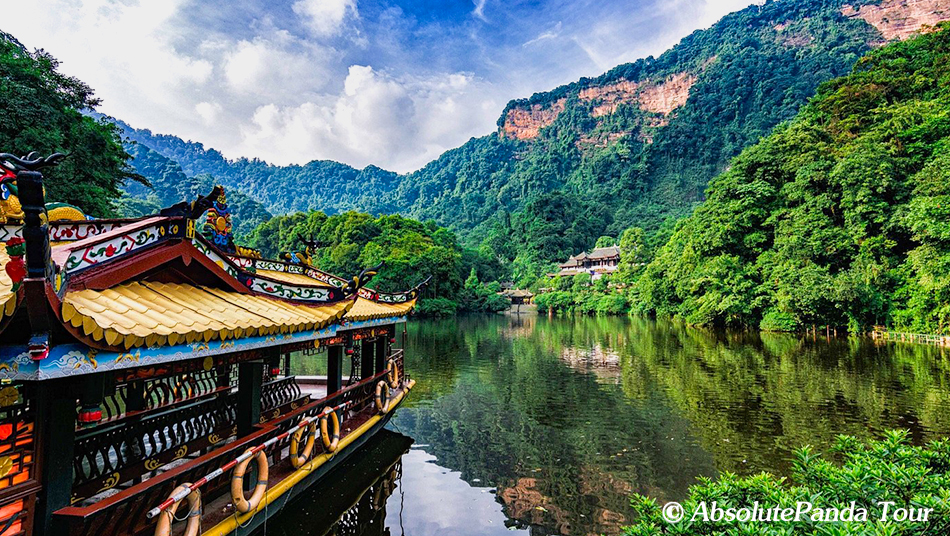
Mount Qingcheng
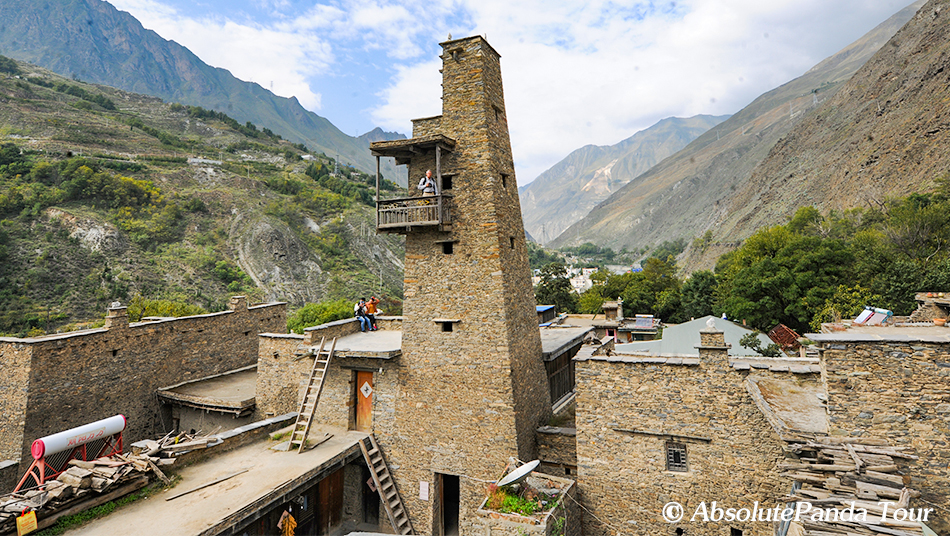
Taoping Qiang Village
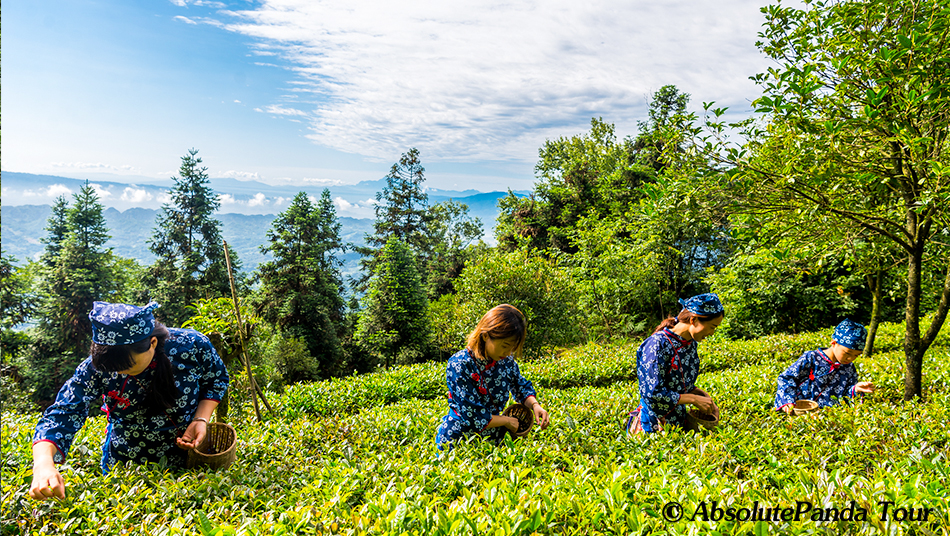
Mount Mengding
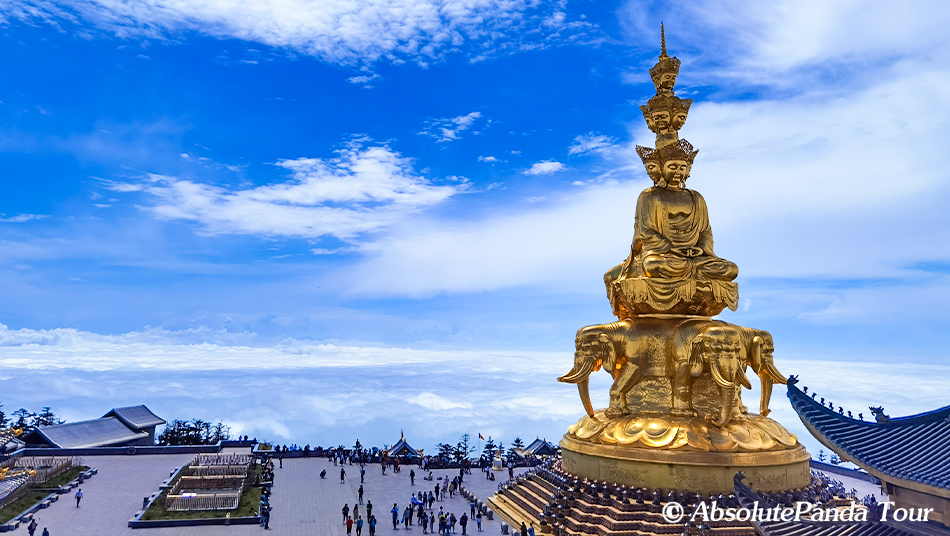
Mount Emei
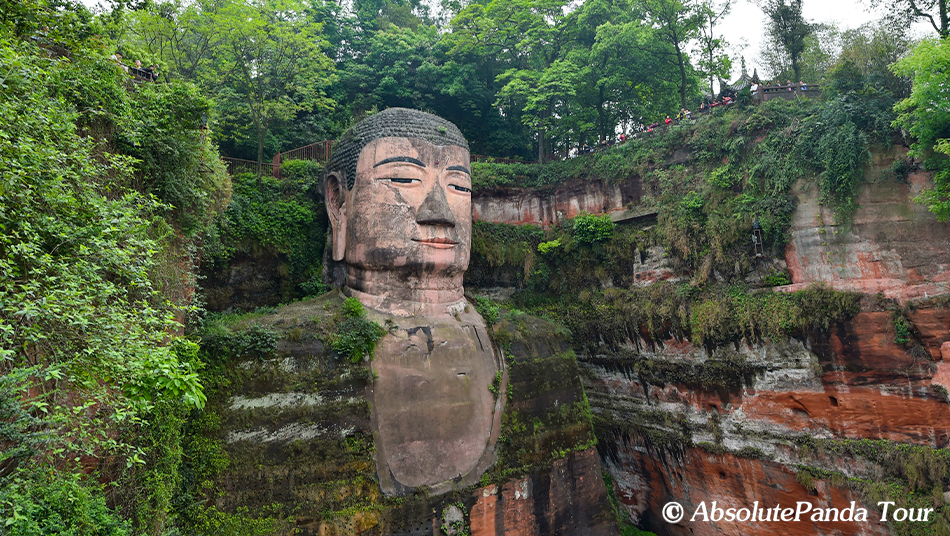
Leshan Giant Buddha
 info@absolutepanda.com
info@absolutepanda.com